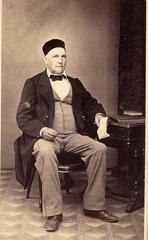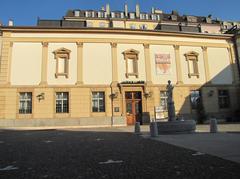Musée d’Art et d’Histoire Neuchâtel: Visiting Hours, Tickets, and Visitor Guide
Date: 04/07/2025
Introduction
Nestled on the scenic shores of Lake Neuchâtel, the Musée d’Art et d’Histoire Neuchâtel (MAHN) is a premier Swiss cultural destination, renowned for its compelling blend of art, history, science, and horological innovation. Established in the late 19th century and housed in an impressive Renaissance Revival building, MAHN invites visitors to explore thematic galleries spanning prehistoric artifacts, fine and decorative arts, and the world-famous Jaquet-Droz automata. Its central location, diverse collections, dynamic exhibitions, and accessible amenities make it a must-see for art lovers, history enthusiasts, families, and travelers. For the most current visiting hours, ticket prices, and event listings, consult the official MAHN website and related resources (myswitzerland.com, artfritz.ch).
Table of Contents
- Introduction
- Historical Context
- Architectural Significance
- Visiting Information
- Highlights of the Collections
- Visual and Interactive Elements
- Frequently Asked Questions (FAQ)
- Practical Tips for Your Visit
- Conclusion
- References
Historical Context
Origins and Foundation
Founded in the late 19th century, the Musée d’Art et d’Histoire Neuchâtel reflects the city’s ambition to preserve and showcase its cultural, historical, and scientific heritage. The museum’s Renaissance Revival edifice, designed by Léo Châtelain, opened in 1885 to house Neuchâtel’s growing collection of art, archaeological finds, and scientific artifacts, previously stored across various locations (myswitzerland.com, whichmuseum.com).
Evolution of Collections
MAHN’s collections have expanded to over 150,000 objects, including fine arts, decorative arts, scientific instruments, horological masterpieces, and rare automata. Particularly significant is the acquisition of the Jaquet-Droz automata in 1906, emblematic of Neuchâtel’s watchmaking legacy. Thematic galleries such as “Nature,” “Civilization,” and “The Sacred” offer fresh perspectives on art and culture (switzerlandisyours.com, torpille.ch).
Role in the Community
The museum serves as an educational and cultural hub, offering regular free admission days, temporary exhibitions, workshops, and events aimed at fostering public engagement and cultural dialogue (mahn.ch).
Architectural Significance
Design and Construction
MAHN’s home is a Renaissance Revival masterpiece by Léo Châtelain, blending 19th-century grandeur with modern functionality. Its lakeside façade features classical motifs and sculptural elements, reflecting civic pride and a vision of culture and enlightenment (artfritz.ch, museumspedia.net).
Exterior and Interior Features
- Exterior: The building’s symmetrical design, monumental entrance, and ornamental cornices create a stately presence along Esplanade Léopold-Robert.
- Interior: Over 20 exhibition rooms are distributed across two levels. The grand staircase—adorned with Art Nouveau murals, stained glass, and ornate ironwork—serves as a dramatic centerpiece (torpille.ch).
Notable Elements and Modernization
- Monumental Staircase: Showcases Léo-Paul Robert’s murals (1886–1894), a highlight of Swiss mural art.
- Concert Hall: Houses the Ruckers harpsichord and hosts musical events.
- Thematic Galleries: Foster cross-disciplinary connections and innovative curatorial approaches.
- Modernization: The museum regularly upgrades its infrastructure for conservation, accessibility, and visitor comfort, while preserving its historic character (whichmuseum.com).
Urban and Cultural Context
MAHN is part of Neuchâtel’s “culture corridor,” near the Musée d’Ethnographie, Laténium Archaeology Museum, historic old town, and lakeside promenade (myswitzerland.com).
Visiting Information
Visiting Hours and Tickets
- Hours (as of July 2025):
- Tuesday to Sunday: 11:00–18:00
- Closed Mondays, Christmas Day, and New Year’s Day
- Check the official website for seasonal or holiday changes.
- Tickets:
- Adults: CHF 12
- Reduced (students, seniors, groups): CHF 8
- Neuchâtel residents: CHF 8
- Students and seniors: CHF 4
- Children under 16: Free
- Swiss Museum Pass: Free admission
- Purchase onsite or online (mahn.ch)
Accessibility
The building is wheelchair accessible, with ramps, elevators, and accessible restrooms. Multilingual exhibit materials (French, English, German) and staff assistance ensure a welcoming experience for all.
Travel Tips
- Getting there: Centrally located at Esplanade Léopold-Robert 1, a short walk from Neuchâtel train station, and accessible via local buses or by car (parking at “Parking du Port” and “Parking Place Pury”) (location info).
- Best time to visit: Weekday mornings or late afternoons for fewer crowds; spring and summer for beautiful lakeside views.
- Photography: Allowed without flash or tripods in most galleries; some temporary exhibits may restrict photography.
Visitor Facilities
- Lockers and coatrooms (free of charge)
- Wheelchairs and baby strollers available upon request
- Baby-changing facilities
- Museum shop with books and souvenirs
- No on-site café, but many options nearby
Highlights of the Collections
- Fine Arts:
Masterpieces by Monet, Degas, Renoir, Morisot, Pissarro, Sisley, Courbet, Corot, Gauguin, and Swiss artists like Ferdinand Hodler (artfritz.ch). - Decorative Arts:
Furniture, ceramics, glassware, textiles, and silverware reflecting regional craftsmanship. - Horology:
Exceptional clocks, watches, and the globally renowned Jaquet-Droz automata—demonstrated on the first Sunday of each month at 14:00, 15:00, and 16:00, or by special arrangement (mahn.ch). - Historical Collections:
Everyday objects, costumes, documents, and artifacts illustrating Neuchâtel’s social and economic evolution. - Numismatics:
Coins and medals from Switzerland and beyond. - Arms and Military History:
The Strubin Collection of French military weaponry (1790–1870). - Murals:
Monumental murals by Léo-Paul Robert, a highlight of the museum’s architectural artistry.
Visual and Interactive Elements
- Virtual Tours:
Preview exhibitions and explore key areas on the museum’s online portal. - Multimedia Displays:
Enhance the experience with high-resolution images and interactive content. - Suggested Images:
Exterior façade, grand staircase, Jaquet-Droz automata, concert hall, and lakeside views (with descriptive alt tags for accessibility).
Frequently Asked Questions (FAQ)
Q: What are the museum’s opening hours?
A: Tuesday to Sunday, 11:00–18:00; closed Mondays and certain holidays.
Q: How much are tickets?
A: Adults CHF 12; reduced rates for students, seniors, and groups; children under 16 free; free with Swiss Museum Pass.
Q: How can I buy tickets?
A: Tickets are available onsite or online via the official website.
Q: Is the museum accessible for visitors with disabilities?
A: Yes, with ramps, elevators, accessible restrooms, and wheelchairs upon request.
Q: Are guided tours available?
A: Yes, guided tours and workshops in several languages; check the website for schedules.
Q: When are the Jaquet-Droz Automata demonstrations?
A: First Sunday of each month at 14:00, 15:00, and 16:00, or by special arrangement.
Q: Can I take photos inside the museum?
A: Yes, for personal use without flash or tripods; check signage for restrictions.
Q: Are there family-friendly activities?
A: Yes, interactive displays, workshops, activity booklets, and stroller access.
Practical Tips for Your Visit
- Languages: Labels are in French, with English and German translations; staff are multilingual.
- Best times: Weekday mornings or late afternoons for a quieter experience.
- Dining: Numerous cafés and bistros are close by, especially around Place Pury and the lakeside.
- Souvenirs: The museum shop offers unique gifts and publications.
- Nearby attractions: Combine your visit with Neuchâtel’s old town, Collégiale Church, Neuchâtel Castle, Laténium Archaeology Museum, and lakeside promenade.
Conclusion
The Musée d’Art et d’Histoire Neuchâtel is a cultural treasure that seamlessly blends art, history, and scientific innovation in a picturesque lakeside setting. Its rich collections, architectural grandeur, and commitment to accessibility make it a vital part of Neuchâtel’s cultural landscape. Whether you are drawn by Impressionist masterpieces, fascinated by Swiss watchmaking, or seeking inspiration in historical artifacts, MAHN promises an enriching and memorable experience. For up-to-date information on visiting hours, tickets, exhibitions, and programs, visit the official website and follow the museum on social media. Make MAHN the start of your journey into Neuchâtel’s vibrant heritage.
References
- Art and History Museum Neuchâtel – MySwitzerland
- Musée d’Art et d’Histoire de Neuchâtel – ArtFritz
- MAHN Official Website
- Musée d’Art et d’Histoire Neuchâtel Visitor Guide
- WhichMuseum – Musée d’Art et d’Histoire Neuchâtel
- Torpille – Musée d’Art et d’Histoire de Neuchâtel
- Collections Online Portal – MAHN
- MAHN Location – Travalour

